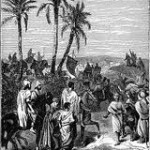Behar (Leviticus 25:1-26:2) — What does the portion teach about the written and the oral Torah. What do we learn about the connection between Mount Sinai and the Land of Israel?
Parshat Emor
Emor ( Leviticus 21:1–24:23) — he powers of stirring the Heavens from below while being wary of the dangers of being too politically correct.
Hatikva – The Hope
 On April 15, 1945, British forces liberated the Bergen-Belsen concentration camp in northern Germany. Sixty-thousand prisoners were living in the camp when the troops arrived, most of them seriously ill. Thousands more lay dead and unburied on the camp grounds. Five days after the liberation, the sick and starving survivors gathered for their first Shabbat service since the fires of destruction began.
On April 15, 1945, British forces liberated the Bergen-Belsen concentration camp in northern Germany. Sixty-thousand prisoners were living in the camp when the troops arrived, most of them seriously ill. Thousands more lay dead and unburied on the camp grounds. Five days after the liberation, the sick and starving survivors gathered for their first Shabbat service since the fires of destruction began.
Counting the Omer: From or To
Towards True Freedom
 In the Torah portion of “Acharei “ we read the following regarding Yom Kippur: “For on this day it shall atone for you to cleanse you. Before the Lord, you shall be cleansed from all your sins”( Vayikra/ Leviticus 16:30).
In the Torah portion of “Acharei “ we read the following regarding Yom Kippur: “For on this day it shall atone for you to cleanse you. Before the Lord, you shall be cleansed from all your sins”( Vayikra/ Leviticus 16:30).
Our sages based on these words have explored the redemptive power of the actual day of Yom Kippur.In the words of the Rambam “ On yom kippur , it is the day itself that atones ..as it is written “For on this day it shall atone for you”( Mishneh Torah ,laws of repentance 1:3)
Parshat Acharei Mot
Acharei Mot Leviticus 16:1-18:30 — Approaching holiness with love of G-d and fear of G-d. Are those opposing forces or necessary components of this journey?
Out Of Exile
 The Jewish people are returning out of a long and painful exile. The healing that needed to occur has been long and arduous. It is a process that will undergo many phases and changes, just as Ezekiel prophesied regarding the return of “the dry bones “( Ezekiel 37).These challenges and changes of our people are mirrored in the lives and journeys of each individual Jew as well. Perhaps an exploration of the rituals and challenges facing an individual in the process of return will give us direction in understanding the challenges facing our people.
The Jewish people are returning out of a long and painful exile. The healing that needed to occur has been long and arduous. It is a process that will undergo many phases and changes, just as Ezekiel prophesied regarding the return of “the dry bones “( Ezekiel 37).These challenges and changes of our people are mirrored in the lives and journeys of each individual Jew as well. Perhaps an exploration of the rituals and challenges facing an individual in the process of return will give us direction in understanding the challenges facing our people.





